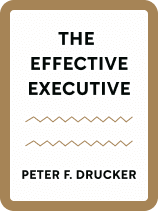

This article is an excerpt from the Shortform book guide to "The Effective Executive" by Peter F. Drucker. Shortform has the world's best summaries and analyses of books you should be reading.
Like this article? Sign up for a free trial here .
Why do people say to “focus on one thing at a time”? How does working on just one thing at a time affect your performance?
According to management consultant Peter Drucker, when you focus on one thing at a time, your work is both better and faster. This applies both to individual and organizational performance.
Here is why you should choose one thing to focus on and give it your all.
The Case for Single Tasking
Drucker argues that the ability to focus on one thing at a time is central to performance because:
- When you focus on one thing at a time, you actually get more done because you get each thing done faster. You also do better work, which strengthens your contribution to organizational performance. (Shortform note: In Quiet, Susan Cain notes that focusing may be easier for introverts than for extroverts, because introverts’ preferred work style is to work methodically on one task at a time and concentrate deeply.)
- You can’t do more than one thing at a time well. (Shortform note: Drucker was ahead of the research in realizing that multitasking yields poor results. We’ll discuss the myth of multitasking later in this section.)
(Shortform note: In The 4-Hour Workweek, Tim Ferriss echoes Drucker’s ideas of focusing: Instead of being so busy that you have to manage your time, he argues for reducing the number of things you have to do as well as decreasing the amount of time you spend on them. To get more done, he says, do less.)
Drucker notes that the principle of focus applies to company as well as individual performance: Companies that try to do too many disparate things don’t excel at anything and therefore fail to differentiate themselves. (Shortform note: Companies can apply focus in two ways: product focus and/or market focus. For example, Apple focuses on producing superior products, while Microsoft is market-focused, bent on discovering and delivering on customer wants and needs.)
Another company pitfall is focusing on preserving legacy products while failing to devote resources to developing products that will sustain the business in the future. Drucker recommends regularly asking, “If we weren’t already doing this, would it make any sense to start doing it?” If the answer is “no,” drop the activity or product. (Shortform note: Besides Drucker’s question, considerations for eliminating a legacy product include cost versus revenue, and the number of customers impacted and their lifetime value (how much revenue that customer will generate for the business for the entirety of the business relationship).)
| How to Focus While Drucker emphasizes the need for and value of focusing, he doesn’t discuss how to focus beyond simply scheduling “alone” time. However, later authors discuss how to achieve focus or do deep (focused) work. Here are several approaches: In Deep Work, Cal Newport argues that you must strengthen your ability to focus by working it like a muscle. He says that after practicing four steps daily for a few months, you’ll increase your ability to do deep work, and raise your level of concentration: Schedule when you’ll use the Internet. Avoid it completely outside these times. Set tight deadlines for yourself that require you to concentrate at the limit of your ability to make the deadlines. (Estimate how much time you’d ordinarily need for the task, cut that time down drastically, and set it as your deadline.)Practice productive meditation—think about a problem while you do a low-intensity physical activity, like walking or showering. In Indistractable, Nir Eyal contends that the key to being able to focus is becoming “indistractable” or resistant to distractions through a four-step method: Control your internal distraction triggers. Build your schedule around your values (so you’re doing what’s important to you rather than reacting to whatever comes up). Reduce external distraction triggers. Create precommitments or pledges you make in advance for how you’ll respond when tempted by a distraction. |
| Multitasking The opposite of focus is multitasking, which Drucker recognized as unproductive. Gary Keller writes in The One Thing that people actually can do two things at once—for instance, walk and talk. But like computers, we alternate our focus. A conflict occurs when a new activity requires a brain channel already in use or when one task demands greater attention—for example when you’re driving and start focusing on a text message instead of on the road. Keller writes that the downsides of multitasking (besides car accidents) are: When you divide your limited brain capacity, you decrease your effectiveness. The more time you spend on a task you switched to, the less likely you are to resume your original task. When you bounce between activities, you lose time as your brain reorients. Multitasking skews your sense of how long it takes to do things and you overestimate the time required. Multitasking wastes time: Researchers estimate that employees are interrupted every 11 minutes and spend a third of their day recovering from interruptions. It also takes longer to do things. Depending on the complexity of the task, switching can add 25% to 100% more time to completing it. When you multitask, you make more mistakes and make bad decisions because you favor new information over old, whether it’s relevant or not. Multitasking creates stress. |
Determine Priorities and Non-Priorities
Once you understand how to focus, the next step is deciding which productive tasks and opportunities you should focus on—that is, which are your priority tasks (things you should focus on one at a time) and which are non-priorities (things you don’t do).
While most people focus on determining priorities, Drucker contends that consciously deciding your non-priorities is equally important, because non-priorities tend to encroach on priorities unless you actively resist or eliminate them. Non-priorities are tasks you’ve decided you won’t do or opportunities you won’t pursue now, if at all. These are activities that offer little or no significant long-term value, but they can be difficult to jettison if they’re someone else’s baby.
| Non-Priorities Several authors, especially sales consultant and author Brian Tracy (Eat That Frog), have built on Drucker’s idea of priorities and non-priorities. To determine what activities you can drop, Tracy recommends these steps: List the work activities that take the most of your time. Ask yourself whether you’d pay someone the equivalent of your salary to do each of them. If not, stop doing them—delegate or eliminate them. Jim Collins (Good to Great), a Drucker disciple, recommends creating a “stop doing” list instead of an annual New Year’s resolution list of things you will do, whether personal or professional. Similarly, Tim Ferriss (The 4-Hour Workweek) proposes a “not-to-do” list of nine things to stop, such as not agreeing to meetings and calls that lack a specific agenda and end time and not spending time with low-profit, high-maintenance customers. |
Priorities
Regarding priorities, Drucker says they’re typically established in one of two ways: You actively decide something is a priority, or it gets pushed to the top of your list by external pressure. When pressure determines what gets your attention, the most important work—which is working on the future—won’t get done. Because it’s non-urgent, it’s easily postponed.
Drucker doesn’t give any specific advice on how to set priorities—he says setting priorities requires courage more than analysis. In his view, courage requires that you:
- Focus on the future instead of the past, that is on innovation rather than legacy products, as noted above.
- Focus on opportunities, not problems. It’s more valuable to translate an opportunity into results for the future than to solve a current problem. (Shortform note: In a later Harvard Business Review article, Drucker wrote that while solving problems is necessary, only exploiting opportunities produces results. He returns to this idea in discussing practice #4, Building on strengths. We’ll explore it further in that section.)
| Methods of Prioritizing Various authors offer specific advice on how to prioritize. In Eat That Frog, Brian Tracy proposes what he calls the ABCDE method for prioritizing a to-do list. Write down everything you have to do for the next day. Then rank each item by marking it with an A, B, C, D, or E, as follows:A—must-do: These tasks are very important. You must do them because not doing them will have serious negative consequences. For instance, an “A” task might be something your boss directed you to do.B—should do: These are tasks that you should do, such as returning a non-critical call or email. They have much less dire consequences than “A” tasks—for instance, someone may be unhappy if you don’t do it.C—would be nice to do: While it would be nice, it doesn’t matter whether you do these tasks or not. Examples include having lunch with a coworker or phoning a friend. These tasks don’t affect your work.D—delegate: These are tasks you can delegate. You should delegate everything possible to create time to do your “A” tasks.E—eliminate: Tasks you can eliminate include things that were important at one time but are no longer relevant, or they’re unnecessary things that have become habits. Any time spent on them is time diverted from an “A” task. In First Things First, Stephen R. Covey suggests categorizing activities in four quadrants: Quadrant 1 activities are important and urgent—for example, work deadlines. Quadrant 2 activities are important but not urgent—for example, personal development. Quadrant 3 activities are urgent but not important—for example, checking your work email on the weekend. Quadrant 4 activities are neither urgent nor important—for example, checking social media. You should spend most of your time on Quadrant 2 activities. In The 4-Hour Workweek, Tim Ferriss advises prioritizing by following two principles: The 80/20 rule or Pareto Principle, which states that 80% of results come from 20% of effortParkinson’s Law, which states that a task will take up as much time as you give it, and the more time you give it, the more important it will seem Thus, you should only do the 20% of your tasks that give you the greatest return, and give yourself short deadlines for those tasks. |

———End of Preview———
Like what you just read? Read the rest of the world's best book summary and analysis of Peter F. Drucker's "The Effective Executive" at Shortform .
Here's what you'll find in our full The Effective Executive summary :
- How to manage yourself before you can manage others
- The five practices that anyone can learn to be more effective
- Why leaders should purposely create disagreements






